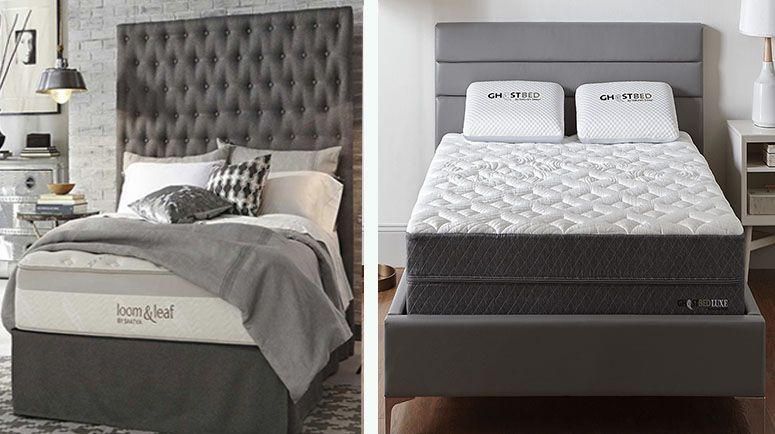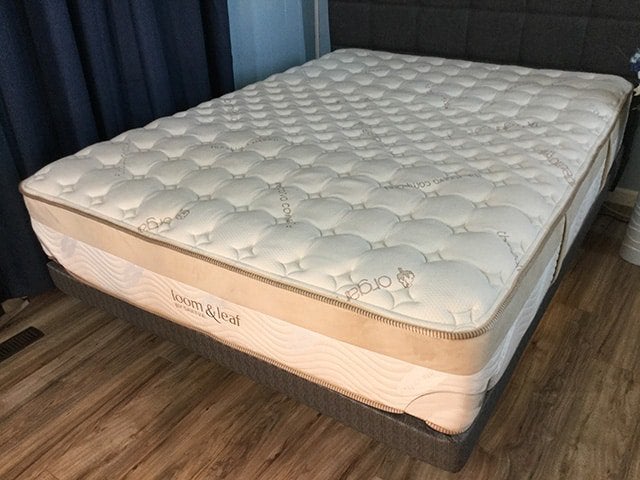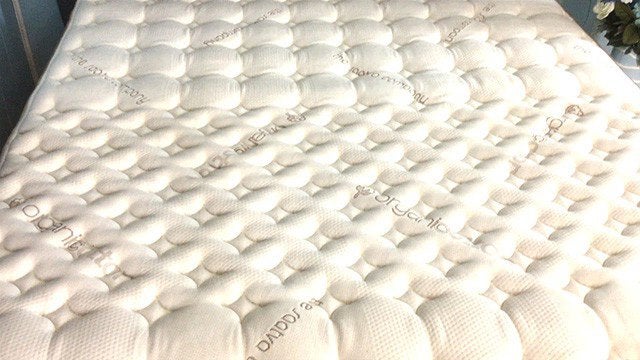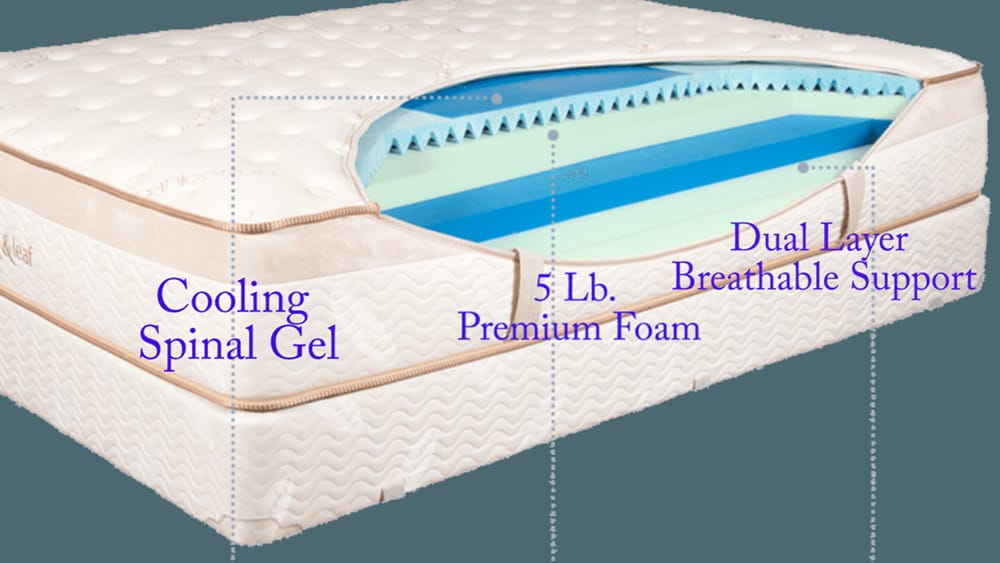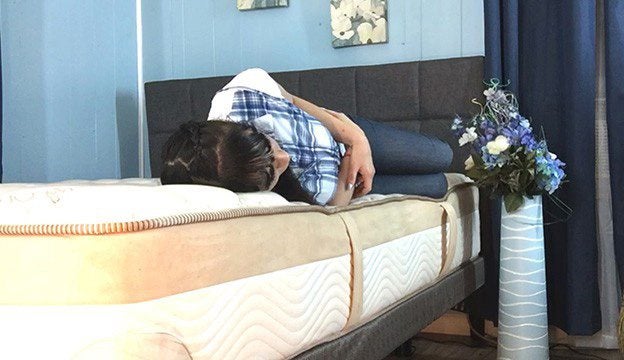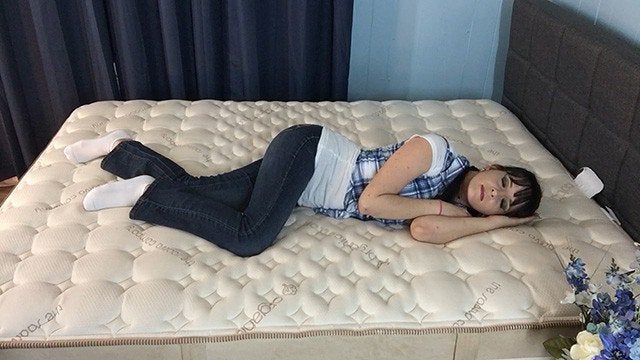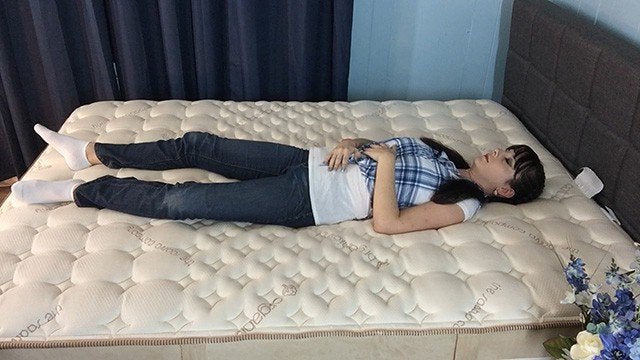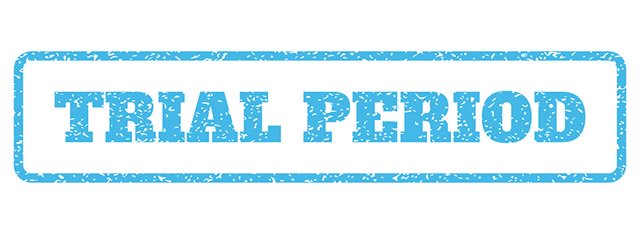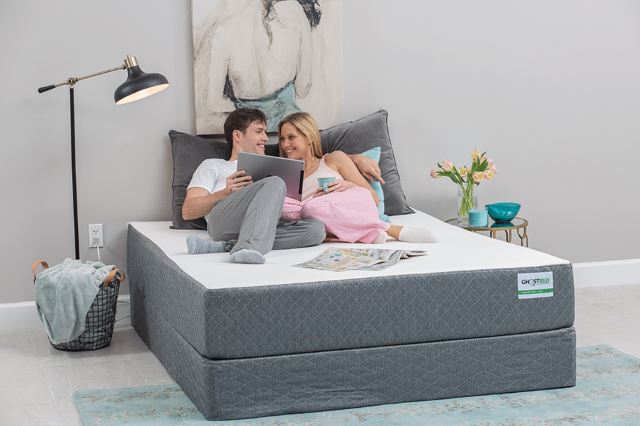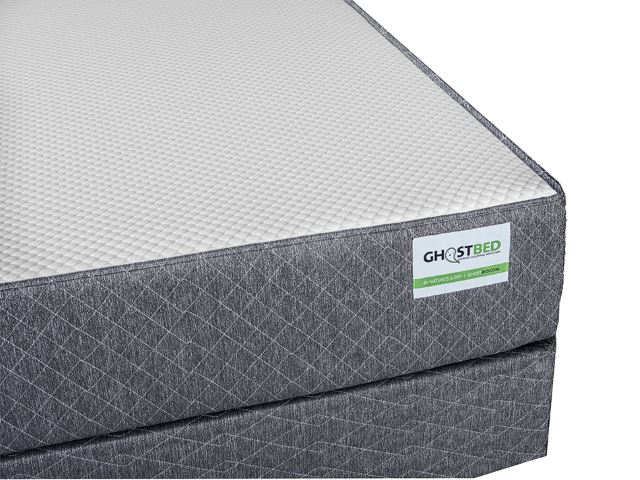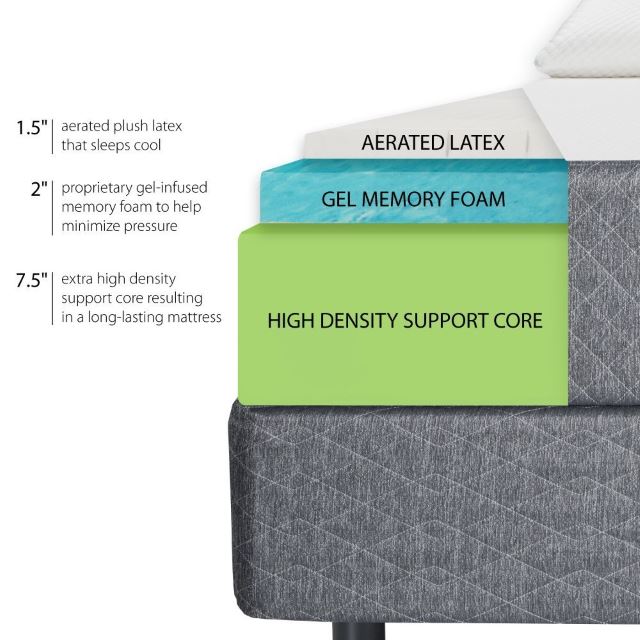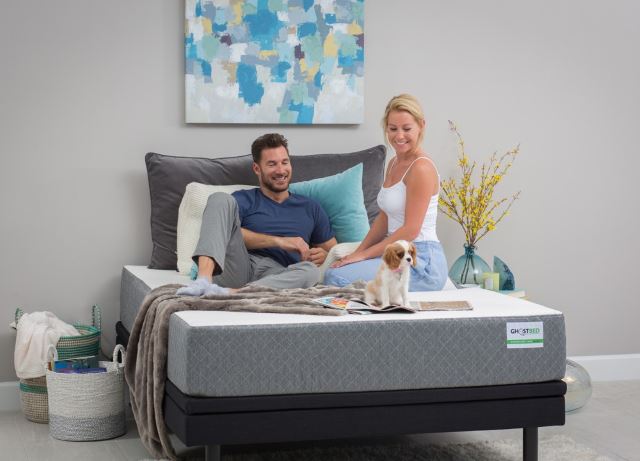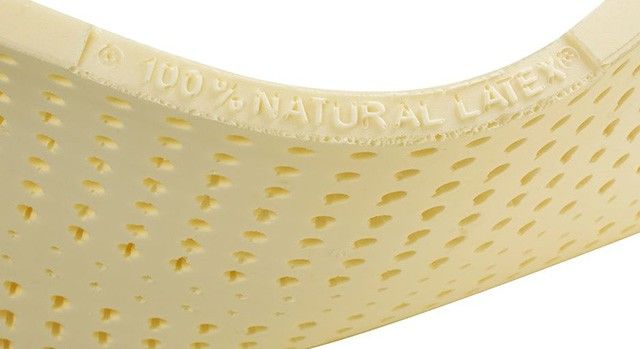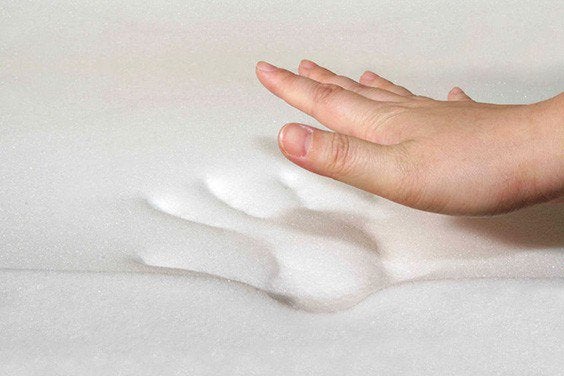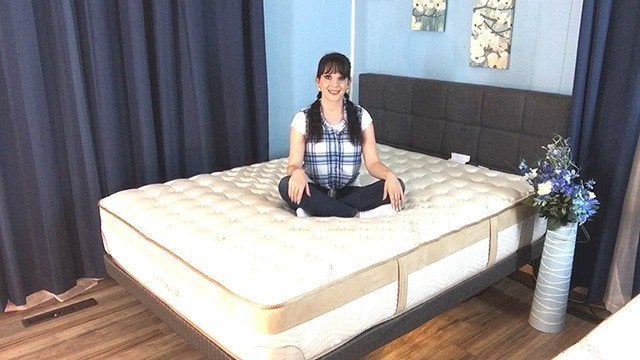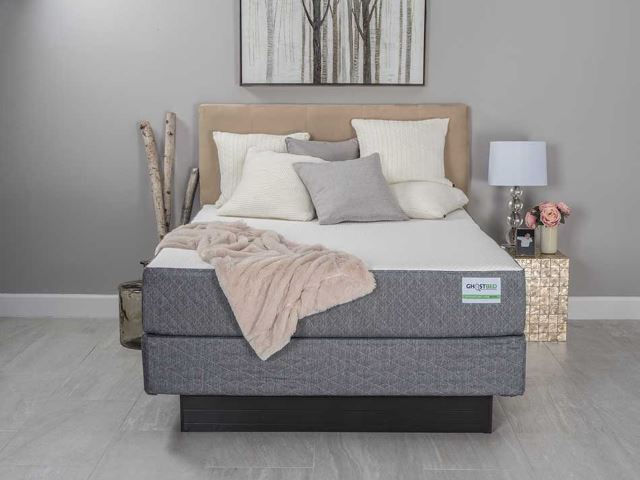The mattress industry has evolved a great deal in the past few decades, traditional polyurethane foam and spring coils have been replaced with memory foam, natural latex, pocketed coils, and an assortment of proprietary foam blends. The industry has also seen a boost thanks to the advent of e-commerce, with many local mattress makers setting up shop online and shipping across the States.
Ghostbed and Loom and Leaf are two brands that are representative of this evolution in both regards. Both are topnotch all-foam products utilizing innovative memory foam and, in the case of the latter, latex layers to provide superb comfort and support at an affordable price point. I’m doing this Loom and Leaf vs Ghostbed Classic comparison to highlight the difference between these two decidedly high-end all-foam mattresses, and to show you the variety that is available to you these days.
Loom and Leaf Breakdown
The Loom and Leaf is a classic memory foam mattress that incorporates a number of innovations to minimize the heat retention that is part and parcel with this material.
Construction
Cover
The Loom and Leaf uses a simple yet elegant organic cotton cover to encase its multiple foam layers. But don’t be fooled by this perceived simplicity – organic cotton is regarded as a luxury bedding material, being both highly breathable and soft. Cotton does have the drawback of becoming wrinkled quickly, but since the cover is stretched so tightly over the mattress, this problem is considerably reduced.
First Layer
2 inches of 4 lbs./cu.ft. gel-swirl memory foam is used to make up the topmost layer of the mattress. This layer is responsible for providing immediate pressure relief for your tired body, and for creating a surface that adapts to your contours to yield a personalized sleep experience.
Thanks to the gel-swirl infusion, this foam layer is able to effectively transport heat away from your body, but the manufacturer doesn’t stop at that: there is a dedicated spinal gel panel to provide extra heat dissipation to your lumbar region since it can accumulate a large part of your body heat. On top of this, the layer has been given an inverted egg-crate construction to set up natural airflow between it and the succeeding layer, so that the heat absorbed by the gel can be removed into the surroundings.
Second Layer
This is another layer of memory foam, but it is given a density of 5 lbs./cu.ft. and greater depth – 2.5 inches. These beefed up specifications enable this layer to yield a more viscous response i.e. it too contours to your shape like the upper layer, but to a lesser degree, so your body sinks less into the mattress.
The extra density also enhances the layer’s durability, and that makes sense since a greater portion of your bodily weight is borne by it after the initial impact is taken up by the first layer.
Third Layer
Next up is a 2” layer of transition foam, intended to smooth the transition between the soft upper layers and the stiff support core that follows. Bulkier individuals will have noticed that their bodies tend to sink through the comfort layers of a mattress, after which they begin to feel the hard base – the transition layer is designed to prevent exactly this issue.
Fourth Layer
This is the base of the mattress and is thus intended to offer a healthy amount of support for your overall body frame, after the upper layers have absorbed the pressure and adjusted to your posture. It is thus comprised of 5.5 inches of high density polyurethane foam. This layer is supposed to be unyielding, to prevent any further sinkage, so your spine is in the correct position at all times when you’re lying on the bed – failure to achieve this can lead to stiffness and aching.
Firmness and Feel
The Loom and Leaf is available in two firmness levels which enables it to cover a wider consumer base than the Ghostbed:
Comfort and Support
- Relaxed FirmSaatva calls this the most popular version of the Loom and Leaf, and rightly so, as it has been designed to evenly balance out comfort and support by placing (roughly) equal emphasis on both the viscoelastic upper layers and the tough, supportive base. As a result, this mattress is able to cater to all kinds of sleep preferences to a respectable degree.The manufacturer has expressed the firmness of this model on a relative scale from 1 to 10, wherein 1 is the softest and 10 is the hardest – it lies between 5 and 7 on this scale.
- Firm
This variant departs from the traditional softness that is expected from memory foam mattresses. It focuses more on the firmness exhibited by its lowers while reducing the plushness of the upper two viscoelastic layers. This makes it less contouring which in turn means there is less of the ‘sinking’ feeling to deal with – something that not everyone can appreciate.
Edge Support
Because of its extensive use of memory foam, the Loom and Leaf is not able to yield satisfactory edge support – however, this is true for all memory foam mattresses: it is simply the price one pays for all the plush, contouring pressure relief; if edge support is a priority, you should consider a product that uses latex (such as the Ghostbed), or even better, an innerspring hybrid mattress.
Cooling
The multiple heat loss features that manufacturer has incorporated into this mattress appear to pay off: the mattress retains significantly less heat than what you’d expect from a memory foam product. Naturally, the inherent property of memory foam to retain heat cannot be mitigated completely, but all things considered, this is one memory foam mattress that shouldn’t become a bother in hot weather.
Motion Transfer
The viscoelastic layers of the Loom and Leaf are able to rapidly absorb all sudden motion, so that none of it is transmitted into the surroundings. In other words, neither you nor your partner will be able to disturb the other due to restless movements. I should point out here though, that this can sometimes become too much of a good thing – the dead response can actually make it a bit difficult to move around in bed!
Unique Features
Signature memory foam response sans the heat retentions
The two memory foam layers of the Loom and Leaf which are responsible for its comfort response behave exactly like you would expect from top quality viscoelastic mattress in all regards, with the exception of one: they don’t trap heat. This is a result of the many heat management features that Saatva has incorporated into the mattress – they really seem to have pulled all the stops.
In a nutshell – you’ve got a memory foam mattress that doesn’t run hot.
Organic cotton cover
The Loom and Leaf, like the other offerings from Saatva, has a fully organic cotton cover to yield a safe, comfortable and cool surface for you to sleep on. Cotton is inherently hypoallergenic and skin friendly, and its breathability also means that the chances of rashes and allergies are minimized.
The Ghostbed, on the other hand, has a plastic blend cover – and although it does have tiny holes to improve breathability, it may not be enough to convince those who are averse to sleeping on a synthetic surface.
Dual firmness choices
Besides the popular Luxury Firm option (which can be compared to the Ghostbed’s singular Medium-Firm level), the Loom and Leaf also comes in a Firm variant. This enables the mattress to target segments of the market that are looking for a bed that can adhere to their sleep posture, but they cannot handle the slow viscosity that comes with a regular memory foam product.
Longer trial period
The Loom and Leaf comes with a 120 day trial period, which is more than a fortnight longer than the Ghostbed’s 101 day policy. While one cannot say that the Ghostbed doesn’t give you enough time to try the mattress out, it’s just that the Loom and Leaf gives a significantly greater window for trial which cannot be neglected as one of its strengths.
Check out our unboxing article here
Ghostbed Breakdown
The Ghostbed Classic is a memory foam / latex hybrid mattress that attempts to capture the best qualities of both materials to yield a uniquely comfortable sleep experience.
Construction
Cover
The Ghostbed sports a soft cover made from a blend of viscose and polyester, and it is stretched tightly over the foam layers to give the mattress a streamlined appearance. Despite its artificial nature, the cover has decent breathability and moisture absorbency thanks to the microscopic pores which have been made on its surface.
First Layer
The uppermost layer of the mattress is, surprisingly, not made from memory foam but from latex – this is quite unorthodox because memory foam is generally considered a top comfort layer material. That said, the continuously aerated latex is able to offer a comparable level of pressure relief and comfort, but with a lot more responsiveness than viscoelastic foam can achieve.
While the manufacturer does not explicitly state that the latex they use has purely natural origins, it can be deduced that, at the very least, this is a synthetic / natural latex blend where natural latex is in greater proportion, since the mattress doesn’t experience heating (which is a common symptom in artificial latex).
Second Layer
This layer is made from memory foam at a depth of 2 inches and a density of 4 lbs./cu.ft. With the latex layer having dealt with the major part of the impact made by your body, this layer is intended to enhance the contouring capability of the mattress and ensure that your pressure points are appropriately relieved from stress.
The foam is infused with cooling gel to deal with the inherent heat retention issue of memory foam. A larger cell structure also ensures that the foam reacts to your thermal profile quicker – meaning that there is a less chance that the foam develops a crater under your weight that becomes noticeable when you change your position during sleep.
Third Layer
This layer is responsible for providing deep support for your frame, so that it doesn’t become bent at an awkward angle while you sleep (which can result in bodily pain in the morning). It achieves this level of firmness through 7.5” of 2 lbs./cu.ft. HD polyurethane foam.
It is worth noting that each of the foam layers in the Ghostbed have a respectable density level – this is quite impressive considering the affordable price of the mattress, and is an indicator that it has been built to last for a long time.
Firmness and Feel
There is only one firmness level in which the Ghostbed is available – Medium Firm.
Comfort and Support
By combining latex and memory foam together to yield both adaptive pressure relieve and responsiveness, and using a solid polyfoam core for deep support, the Ghostbed creates a highly balanced sleep solution that can address the needs of a wide variety of sleep styles and requirements this is reflected in the Medium Firm designation this mattress gets from the manufacturer (numerically, they express it at 6.5).
From my own experience, this mattress may seem to be a bit firmer than its rating for the first few days – this can be attributed to the latex layer at the top; the material is known to have a slightly extended break-in period.
Edge Support
The responsive action of the latex layer combines with the robust support of the thick HD polyfoam layer to yield satisfactory edge support – considering that this is an all-foam mattress. The memory foam layer in the middle does mean that it will yield some under your weight, but this won’t be as bad as the sinking and slipping you would have experienced had this layer been on the top.
Compared to the Loom and Leaf, the Ghostbed should yield markedly better edge support, as the former exclusively uses plush memory foam for its upper layers.
Cooling
The breathable blended cover, the aerated design of the uppermost latex layer, the gel infusion in the memory foam layer – these three features work in tandem to ensure good thermal ventilation for the Ghostbed.
As a consequence, this mattress will let you sleep a lot cooler than is the norm for all-foam products. Furthermore, since thanks to the large-celled viscoelastic foam structure, you will also feel less trapped by the mattress, which can also make it easier to sleep in hot and humid climates.
Motion Transfer
The mattress does have a slightly bouncy characteristic because of the reactive nature of its latex layer, but for the most part, its ability to block out sudden movements is comparable to other foam products. No doubt, the deadening response of the intermediate layer plays a central role in enhancing the motion isolation property of the Ghostbed.
It is also worth noting that in exchange for the generally negligible amount of bounce introduced by the latex, you also get a lot of ease in getting in and out of bed – a wholly memory foam comfort layer would have created difficulties in this.
Unique Features
Unique combination of latex and viscoelastic foam
As I’ve discussed above, the norm in the mattress industry is to have memory foam in the uppermost layer of the mattress because of its plush, contouring feel that is naturally geared for pressure relief. Ghostbed’s manufacturers however, have decided to push this to second place in favor of an aerated latex layer that, while being pressure relieving in its own right, is also a lot more reactive to changes in your sleep position.
Due to this design switch, the mattress seems a bit firm for the first few days after unboxing as the latex takes its time to get broken in. Once this happens though, you’ve got a bed that is both highly contouring and highly responsive i.e. the best of both worlds. Together with the stiff HD polyfoam layer, the Ghostbed thus yields a nice balance between pressure relief and support.
Latex
Viscoelastic Foam
Superior edge support
While it is obviously not as sturdy as an innerspring mattress, the Ghostbed’s latex upper layer, together with its support core, is able to sustain you just enough when you’re sitting on the side of the bed that you don’t slip downwards. This is in contrast with most all-foam mattresses, and indeed, the Loom and Leaf.
Lower cost
While both the Loom and Leaf and the Ghostbed Classic are quite affordable and offer incredible value for your investment, between the two, it is the Ghostbed that is more economically priced (even without the $100 discount that is currently on offer with it). Even if your budget forces you to choose it over the Loom and Leaf, remember that you’re getting a pretty sweet deal: high quality foam (latex included), responsive support, solid cooling, and a longer warranty period to boot.
Longer warranty
The Ghostbed comes with a 20 year warranty compared to the Loom and Leaf’s 15 year policy. While normally I wouldn’t consider a warranty longer than 10 years to be significant (seeing as how most mattresses are too worn out by that time to be warrantable any longer), in the case of the Ghostbed, it must be noted that all the foam layers have high densities and latex is one of the most durable bedding material around.
Both these factors justify the confidence that this manufacturer has in the longevity of their product, which is why one can interpret this longer warranty as indicator of superior durability.
Check out our unboxing article here
Which One To Get?
Loom and Leaf
Here are some reasons to get the Loom and Leaf:
- You want a true memory foam mattress that doesn’t run hot: As detailed above, the Loom and Leaf stands apart from other memory foam mattresses because of its effective heat management system. Aside from that, the experience is as plush, contouring, and cushioning as one could desire from a viscoelastic foam product – so if you’ve held out on getting a viscoelastic mattress because you’re sensitive to temperature rise, this could be a good choice for you.
- You prefer an organic cover: The Loom and Leaf’s pure organic cotton cover will certainly appeal to individuals who are averse to overly exposing themselves to synthetic chemicals. Moreover, natural cotton does not lead to any allergic reactions whereas the same cannot be said for artificial materials, which is another reason to choose the Loom and Leaf over the Ghost bed.
- You’re looking for a firm all-foam product: The Loom and Leaf comes in an additional Firm variant, which is specifically geared towards individuals who find usual memory foam mattresses too soft and pliable for their sleep styles (e.g. stomach sleepers) and weights (overweight sleepers). Such an option is not available in case of the Ghostbed.
- You need a longer period to make up your mind: The Loom and Leaf’s longer trial period gives you more time to test the mattress out and see if it fits your needs – if you’re not sure whether a new mattress is the perfect solution for you, you may find this extra time frame useful to further solidify your decision either way.
Ghostbed
- You want a mattress that is both contouring and highly responsive: Thanks to the combined action of the latex and memory foam layers, the Ghostbed is able to provide the sleeper with both viscoelastic pressure relief and latex-like responsiveness – this is impossible for the Loom and Leaf, since it relies exclusively on memory foam. If you’re one of those sleepers who cannot handle the dull, enveloping feel of regular memory foam beds, the Ghostbed is definitely worth consideration.
- You have trouble getting out of / moving around in your bed: Continuing on the previous point, some of us are restless sleepers who tend to change positions in their sleep, whereas others have difficulty in getting out of bed because of an injury or simply excessive weight. Such sleepers are ill-suited for viscoelastic foam mattresses with their lack of reactivity, but the Ghostbed’s latex layer makes it a viable option.
- You’re on a budget: The Ghostbed is priced lower than the Loom and Leaf – the gap isn’t too big, but it is still enough to be meaningful for someone restricted by a tight budget who is on the lookout for a top quality sleep solution.
- Edge support is important for you: If you’re going to be sitting on the side of the bed frequently, for instance, to care for sick family member or to read your child a story before bed, you’ll need a mattress that can hold up your backside comfortably during this time. The Ghostbed is a far superior candidate in this regard than the Loom and Leaf for reasons already detailed above.
- A longer warranty matters to you: This is one of those rare cases where I would concede that a longer warranty is indicative of greater durability – I’ve already discussed this in detail in the preceding section, so in short, if you find it comforting that your mattress has a longer warranty (and will thus probably last longer), you may want to go for the Ghostbed instead of the Loom and Leaf.
I hope you found this comparison of two modern all-foam product of use in your search to find the best mattress for your bed. Remember to share it with others who are looking for a new mattress too. If you’ve got any further questions, or would like to provide some feedback, make free use of the comments section below.
Loom and Leaf vs Ghostbed Comparison
| Loom and Leaf | Ghostbed | |
|---|---|---|
| Layers Used |
|
|
| Height | 12 inches | 10 inches |
| Firmness | Medium-Firm, Firm | Medium-Firm |
| Motion Transfer | Minimal | Minimal |
| Breathability | Above average | Slightly higher than average (for an all-foam product) |
| Trial Period | 120-day | 101-nights |
| Warranty | 15-year | 20 years |
| Pricing (Queen) | $1,699 | $895 (currently discounted to $795) |
| Shipping | Free across the US | Free across the US |
| Discount | None at present | $100 Discount |
